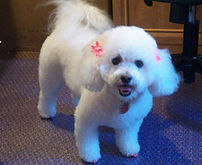

Rosa's Precious Bichons


Bichon's Coat & Color
Coat
The texture of the coat is of utmost importance. The undercoat is soft and dense, the outer coat of a coarser and curlier texture. The combination of the two gives a soft but substantial feel to the touch which is similar to plush or velvet and when patted springs back. When bathed and brushed, it stands off the body, creating an overall powder puff appearance. A wiry coat is not desirable. A limp, silky coat, a coat that lies down, or a lack of undercoat are faults.
Trimming
The coat is trimmed to reveal the natural outline of the body. It is rounded off from any direction and never cut so short as to create an overly trimmed or squared off appearance. The furnishings of the head, beard, mustache, ears and tail are left longer. The longer head hair is trimmed to create an overall rounded impression. The top-line is trimmed to appear level. The coat is long enough to maintain the powder puff look which is characteristic of the breed.
Bichon Puppy's Coat
It's important to know, that the Bichon Frise’s coat will change drastically from puppy to adulthood. Their baby coat can be curly, straight or wavy. This does not mean that they will have the same coat when they are fully grown. No one can guess what the Bichon's coat will look like. The look of the parents will help to determine that, but no one can guess how many generations back your particular Bichon has come from. Some straight haired babies develop a lot of curl and some curly babies get straighter hair as adults. Each puppy is different.
When you first get your Bichon, he/she will have a light fluffy fur coat but at around three to six months of age this will change and he/she will grow in his/her beautiful soft coat.
Yes, he/she will lose his/her (infant hair) and go through a stage of having a thin layer coat, followed by growing in a thicker adult coat. This can happen anywhere from 3-6 months. His/her full adult coat should be in place by 3 years of age. And yes, breeding and bloodlines do determine exactly how full a dog's coat will be. The male's hair tends to grow in faster than the female's does.
The Bichon coat is unique. The undercoat is soft and dense, the guard hairs coarser and curlier. When trimmed, the coat follows the lines of the body and is left long enough to give the breed's characteristic poufy appearance, with hair left longer on head, ears, beard, and tail. The coat should not be wiry, limp, or over-soft.
A baby Bichon can also have buff, cream, apricot shading. These blushes of color fade during the babies first year until your puppy becomes a white puff of cloud.
A Bichon Frises fur is white but their skin will develop black or dark pigment spots. These spots so I have been told tell that they indicate that the dog has very good immunities. I am not a scientist so I can't tell you why.
I do know these black spots are normal and desirable. The skin pigmentation is what breeders try to achieve, and your puppy will eventually look like a piebald all over when bathed. This pigmentation gives the puppy his/her black lips and halos around her eyes as well as her black button nose.
Color
Color is white, may have shadings of buff, cream or apricot around the ears or on the body. Any color in excess of 10% of the entire coat of a mature specimen is a fault and should be penalized, but color of the accepted shadings should not be faulted in puppies.
